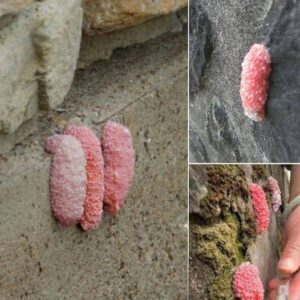
When you think of snails, you might imagine slow-moving creatures leaving a silvery trail behind. But the apple snail (Pomacea), native to South America, is proving to be far more than a harmless garden inhabitant. It is a giant species that threatens biodiversity and damages crops. One of the most notable signs of its presence is its striking pink eggs, which are now raising alarm in gardens and wetlands across the globe.
Apple Snails: A Giant Threat
The apple snail is not your average snail. This freshwater gastropod can grow to an impressive size, with some reaching up to 10 centimeters in height. Their massive size is matched only by their prolific reproduction. A single female can lay between 400 to 600 eggs in one go, usually in clusters, and these eggs are often bright pink or orange.
While these clusters may look like decorative beads, they are far from harmless. Once hatched, the apple snails pose a real threat to agriculture and ecosystems, devouring aquatic plants at an alarming rate. They are particularly destructive in rice fields, where they feed on tender young plants, causing significant economic damage.
The Spread of the Apple Snail
Originally native to South America, the apple snail has spread across multiple continents due to its incredible adaptability. Global warming has further aided its spread, with the species now well established in North America. It was introduced to Asia in the 1980s, where it became notorious for wreaking havoc in rice paddies, and it has even found its way to Europe.
In France, the apple snail was first reported in 2018 near Fréjus, where it was discovered in a reservoir. Emergency measures were taken to contain the population, including restricting access to the affected areas and collecting the snails. Despite these efforts, the species continues to spread, particularly in humid environments like lakes, ponds, and swamps.
A Global Invasive Species
The apple snail is not only a nuisance for gardeners and farmers. It is considered one of the 100 most invasive exotic species in the world. Its rapid reproduction and adaptability make it incredibly difficult to control, and it poses a significant threat to biodiversity. These snails devour aquatic vegetation, impacting ecosystems that rely on plant life for stability and the survival of other species.
What Can You Do?
In areas where the apple snail has been detected, authorities are urging individuals to be vigilant. The striking pink eggs are often found attached to leaves or branches near water sources. If you spot these egg clusters in your garden or a local waterway, it is important to report them to environmental authorities. Early detection and reporting can help slow the spread of this invasive species.
Conclusion
The pink eggs of the apple snail may look pretty, but they are a sign of a serious environmental threat. This giant snail, once prized by aquarists, has proven to be a destructive force in many regions worldwide. Efforts to control its spread are ongoing, but it requires collective vigilance. By staying alert and reporting any sightings of pink eggs, we can all contribute to protecting biodiversity from this invasive menace.